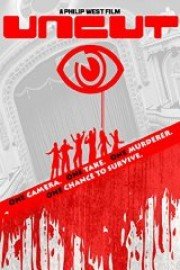-
Genres
-
CastShaun WilliamsonLois Winstone
-
DirectorPhilip West
-
Release Date2013
-
MPAA RatingR
-
Runtime1 hr 21 min

Uncut is a 2009 British thriller-horror film directed by Philip West, notable for its ambitious execution as a single continuous 80-minute shot. Starring Shaun Williamson and Lois Winstone, the film unfolds in real time within the confines of a decaying Victorian theater in provincial England, blending elements of psychological suspense, dark comedy, and slasher horror into a claustrophobic and unsettling experience.
The story centers around the final performance of a struggling pantomime production. The show has been a disaster, drawing only a handful of locals and leaving the cast and crew disillusioned and bitter. As the curtain falls on the last night, a small group of performers and staff—including the pantomime leads Clarice and Nathan, the womanizing director Derrick, and the obscure stage assistant Janet—retreat to the theater’s basement for a private wrap party. Tensions simmer beneath the surface, fueled by personal grudges, romantic entanglements, and professional disappointments.
Shaun Williamson plays Marc, a seasoned actor whose presence adds gravitas and a touch of sardonic wit to the ensemble. His character is both weary and perceptive, navigating the increasingly bizarre and dangerous events with a mix of skepticism and survival instinct. Lois Winstone portrays Clarice, one of the pantomime leads and a central figure in the unfolding drama. Her performance is layered with vulnerability and defiance, capturing the emotional complexity of a woman caught between ambition and fear.
As the party begins, the mood quickly shifts from awkward celebration to creeping dread. When Derrick disappears and is later found murdered in a gruesome fashion, panic sets in. The group realizes they are locked inside the theater, and the killer is among them. What follows is a tense and disorienting descent into paranoia, as alliances fracture and suspicions mount. The characters are forced to confront not only the threat of death but also the secrets and resentments that have long festered beneath their professional facades.
The film’s defining feature is its single-take format, a bold technical choice that heightens the immediacy and intimacy of the narrative. The Steadicam work is relentless, weaving through corridors, stairwells, and dressing rooms without pause, creating a voyeuristic sense of immersion. This approach amplifies the tension, as there are no cuts to relieve the viewer or shift perspective. Every moment unfolds in real time, and the audience is trapped alongside the characters, experiencing their fear and confusion without respite.
Uncut’s visual style is raw and unpolished, reflecting the grimy, decaying setting of the theater. The lighting is dim and atmospheric, casting long shadows and emphasizing the claustrophobic architecture. The sound design is equally effective, with ambient creaks, distant echoes, and sudden silences contributing to the film’s eerie tone. The lack of a traditional score allows the natural sounds of the environment to dominate, reinforcing the sense of realism and immediacy.
Thematically, Uncut explores the fragility of identity and the corrosive effects of ambition and failure. The theater, once a place of performance and illusion, becomes a prison where facades crumble and true selves are exposed. The characters, each nursing their own disappointments and desires, are stripped of pretense as the situation deteriorates. The film probes the psychological toll of artistic pursuit, the desperation for recognition, and the thin line between performance and reality.
While the film’s low budget and experimental format may limit its polish, Uncut compensates with atmosphere and audacity. The performances, though occasionally uneven, are committed and intense, with Williamson and Winstone providing standout turns. The ensemble cast contributes to the chaotic energy, with each character adding a distinct voice to the escalating tension.
Uncut is not a conventional horror film. It eschews jump scares and elaborate effects in favor of psychological unease and real-time suspense. Its one-take structure demands patience and engagement, rewarding viewers with a uniquely immersive experience. For fans of independent cinema and experimental storytelling, the film offers a compelling exploration of fear, identity, and the dark side of performance.
Ultimately, Uncut stands as a testament to creative ambition in filmmaking. By embracing its limitations and pushing the boundaries of form, it delivers a haunting and memorable narrative that lingers long after the final frame. It’s a chilling reminder that sometimes, the scariest stage is the one where the curtain never falls.
Uncut is a 2013 comedy with a runtime of 1 hour and 21 minutes.